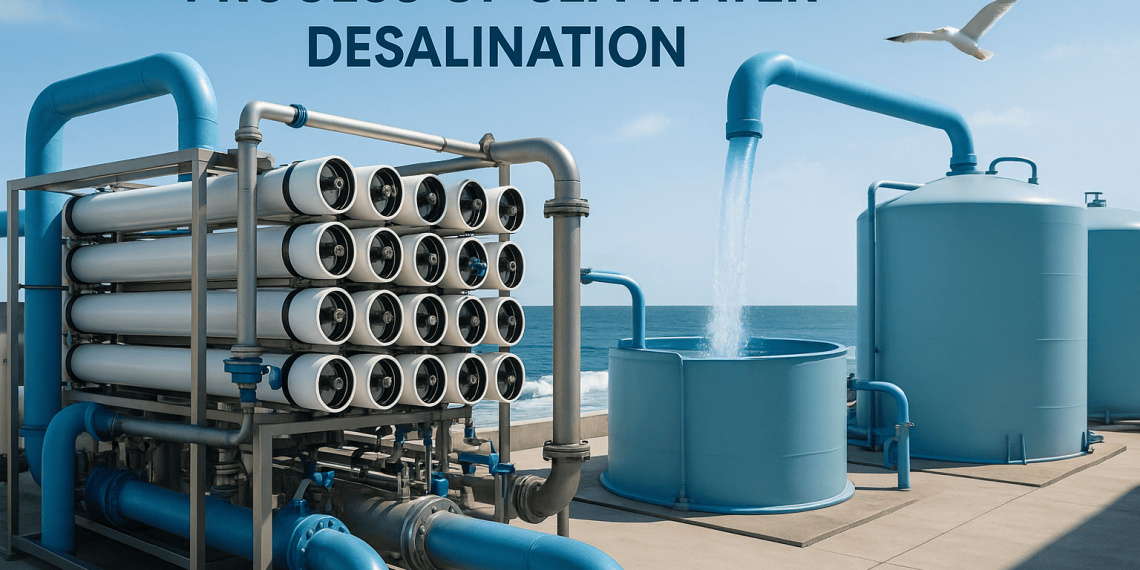Last updated on September 18th, 2025 at 02:05 pm
Desalination, also popularly known as desalting, is the process of removing salt from the ocean water to convert it into a fresh water source. The water which is desalinated can be used for various purposes like drinking, industrial, commercial and agricultural use.
In an era where freshwater scarcity is becoming an escalating global crisis, the desalination of seawater stands as one of the most viable solutions. At our core, we understand the complexity of transforming saline water into a sustainable freshwater source. The process of seawater desalination is a multi-stage, technically precise operation that ensures high-quality water suitable for domestic, agricultural, and industrial applications.
Why Seawater Desalination Matters in Today’s Environment
With nearly 97.5% of the Earth’s water stored in oceans and seas, and only a minuscule percentage available as freshwater, the conversion of saline water into usable forms is imperative. As population growth, industrial expansion, and climate change strain traditional water resources, seawater desalination offers a consistent, weather-independent water supply.
Step 1: Seawater Intake and Pre-Screening
The desalination journey begins with the intake of seawater, typically from coastal areas. Intake systems must be engineered to minimize environmental impact and reduce damage to marine ecosystems. Two primary methods are employed:
- Open Intakes: Large-volume pumps draw water directly from the ocean.
- Subsurface Intakes: Water is filtered naturally through beach sediments before reaching the system.
Once collected, pre-screening involves the removal of large debris, fish, and other particulates using bar screens and coarse filters. This protects downstream components from fouling and mechanical damage.
Step 2: Pre-Treatment – Preparing Seawater for Desalination
Before entering the core desalination unit, seawater undergoes pre-treatment to eliminate suspended solids, biological contaminants, and chemical pollutants. The efficiency of this stage is critical for long-term performance and membrane lifespan.
Key components of pre-treatment include:
- Coagulation and Flocculation: Chemicals like ferric chloride or aluminum sulfate cause suspended particles to aggregate.
- Media Filtration: Dual or multi-media filters trap fine particulates.
- Cartridge Filtration: Final polishing filters (usually 5-micron) to remove residual impurities.
- Chemical Dosing: Antiscalants, biocides, and pH adjusters are introduced to stabilize the water chemistry.
Step 3: Core Desalination via Reverse Osmosis (RO)
The most prevalent method in modern desalination facilities is Reverse Osmosis, a pressure-driven membrane process that separates dissolved salts and impurities from water molecules.
How Reverse Osmosis Works
- High-pressure pumps (800–1200 psi) force seawater through semi-permeable membranes.
- These membranes allow only water molecules to pass, retaining salts, pathogens, and organics.
- The output is twofold:
- Permeate (Product Water): Clean, desalinated water.
- Concentrate (Brine): Saline reject stream.
Advanced systems incorporate energy recovery devices (ERDs) like pressure exchangers, significantly reducing operational energy demands by recycling pressure from the brine.
Alternative Desalination Technologies
While RO dominates, other technologies serve niche or large-scale applications:
Multi-Stage Flash Distillation (MSF)
- Seawater is heated and flashed into vapor across successive chambers with decreasing pressure.
- Vapor condenses on heat exchanger tubes, yielding freshwater.
- Extremely durable and suited for large-scale municipal desalination.
Multi-Effect Distillation (MED)
- Operates on similar principles to MSF but with higher thermal efficiency.
- Each effect uses the vapor from the previous one for heating, minimizing energy usage.
Vapor Compression (VC)
- Utilizes mechanical or thermal compression of vapor.
- Typically applied in smaller, isolated installations where electricity is accessible.
Step 4: Post-Treatment – Water Conditioning
After desalination, the water is pure but may lack essential minerals and stable pH for safe distribution. Post-treatment reintroduces:
- Calcium and Magnesium for taste and corrosion control.
- Carbon Dioxide for pH stabilization.
- Chlorination or UV Sterilization for microbial safety.
- Fluoride (where required) for dental health compliance.
This stage ensures the water meets or exceeds WHO and EPA drinking water standards.
Step 5: Brine Management and Environmental Discharge
Brine, the highly saline concentrate from desalination, must be responsibly managed to prevent ecological disruption. Effective brine handling includes:
- Diffuser Systems: Blend brine with seawater at the discharge point to reduce salinity shock.
- Zero Liquid Discharge (ZLD): Advanced systems that recover almost all water and leave solid salt residue.
- Deep-Well Injection and Solar Evaporation Ponds in arid zones.
Strict adherence to local environmental regulations is essential for sustainable operations.
Energy Considerations and Cost Optimization
Desalination has historically been criticized for its high energy footprint. Modern facilities address this with:
- Energy Recovery Devices (up to 98% efficient).
- High-efficiency membranes and advanced pre-treatment.
- Hybrid Systems integrating solar, wind, and geothermal energy.
- Smart monitoring systems for predictive maintenance and optimized flows.
While costs vary, ongoing innovations are pushing the cost of desalinated water below $0.50 per cubic meter in many regions.
Materials and Equipment in Desalination Plants
To resist corrosion and biofouling in saline environments, materials used must be marine-grade and chemical-resistant:
- Duplex Stainless Steel and Titanium for high-pressure piping and membrane housings.
- HDPE and PVC for low-pressure lines and brine handling.
- Epoxy-lined tanks, ceramic membranes, and UV-resistant polymers for long-term durability.
Applications of Desalinated Water
Desalinated water is widely used across sectors, including:
- Municipal Supply: Drinking water for coastal cities and island nations.
- Industrial Processing: Boiler feedwater, electronics manufacturing, and textiles.
- Agriculture: Drip irrigation systems using blended desalinated water.
- Emergency Relief: Mobile desalination units in disaster zones and military bases.
Why can’t Desalination be used on a large-scale?
- Desalination is a highly efficient and effective method to convert salted water into pure and fresh drinking water but is also highly energy intensive. So, it becomes quite difficult to consider it on large-scale. For this reason, other options are considered before choosing desalination as a solution to the water crisis issue in a region. The agencies, governments, and authorities always consider drilling wells, installing treatment plants and using conservation methods before actually going for seawater desalination to provide the population with the fresh and pure water.
- Another reason for not opting desalination as a solution when it comes to providing water supply on a large-scale is money. There are things which make desalination process an expensive one. There are cases where water needs to be treated before the process of desalination takes place. This will require equipment, manpower, and facilities as well, which makes water expensive. Thus, aside from consuming a great deal of energy desalination is also a costly process.
Future of Sea Water Desalination
We are witnessing a new era where AI-driven process control, next-gen membranes, and off-grid solutions redefine the potential of seawater desalination. Emerging methods like membrane distillation, capacitive deionization, and forward osmosis promise even greater efficiency and lower carbon footprints.
As global water demand intensifies, the refined, scalable, and cost-effective process of seawater desalination remains a cornerstone in securing our planet’s freshwater future.
Seawater Desalination system FAQs:
- What is seawater desalination?
Seawater desalination is the process of removing dissolved salts and other impurities from seawater to produce fresh, drinkable water suitable for human consumption, agriculture, and industrial use.
- Why is seawater desalination important?
Desalination is vital in regions facing water scarcity, especially coastal areas with limited freshwater resources. It provides a reliable, sustainable supply of clean water for growing populations, industries, and agriculture.
- What are the main methods of seawater desalination?
The two most common methods are:
- Reverse Osmosis (RO): Uses semi-permeable membranes and high pressure to filter out salts.
- Thermal Distillation: Heats seawater to produce vapor, which is condensed into freshwater.
- How does the reverse osmosis (RO) desalination process work?
In RO desalination, seawater is pretreated to remove large particles and microbes, then pumped under high pressure through special membranes that block salt molecules while allowing water molecules to pass through, producing freshwater.
- What is thermal desalination and how does it differ from RO?
Thermal desalination involves heating seawater until it evaporates and then condensing the vapor into freshwater. Unlike RO, which relies on membranes and pressure, thermal methods use heat energy, often from fossil fuels or renewable sources.
- Is desalinated water safe to drink?
Yes. Desalinated water is safe to drink once minerals are added back to balance its taste and nutritional value. The process ensures harmful salts, microorganisms, and contaminants are removed.
- What are the challenges of seawater desalination?
Some challenges include:
- High energy consumption
- Cost of construction and operation
- Disposal of concentrated brine (salt-rich wastewater)
- Environmental impacts on marine ecosystems
- What happens to the salt removed during desalination?
The removed salt and concentrated brine are usually discharged back into the sea. However, this must be carefully managed to prevent harm to marine life. Some industries also explore using the extracted salts for commercial purposes.
- Is desalination environmentally friendly?
Desalination provides clean water but raises environmental concerns such as greenhouse gas emissions from energy use and ecological effects from brine discharge. Using renewable energy and advanced brine management helps reduce these impacts.
- Which countries rely most on seawater desalination?
Countries in the Middle East (like Saudi Arabia, UAE, and Kuwait), as well as regions in Australia, Spain, and the U.S. (California, Texas), rely heavily on desalination to meet their freshwater needs.











The moon goes by many names. August saw the full sturgeon moon while in March sky-gazers may have witnessed the blood moon, which occurs when the satellite appears to turn red during a lunar eclipse. You may have also heard of a blue moon, the second full moon to happen in one month.
And then there is the black moon, occurring this weekend, which is rare — and invisible.
This phenomenon will occur Friday night into the early hours of Saturday. The moon will be closest to the sun at 2:06 a.m. ET Saturday, according to EarthSky.
[url=https://skyiwredshjnhjgeleladu7m7mgpuxgsnfxzhncwtvmhr7l5bniutayd0.net]skyiwredshjnhjgeleladu7m7mgpuxgsnfxzhncwtvmhr7l5bniutayd onion[/url]
What is a black moon?
Like a blue moon, a black moon isn’t an official term, but it refers to the second new moon in a month. It happens once every 29 months.
A new moon occurs when only its far side is illuminated by the sun, making it invisible from Earth. It marks the beginning of the lunar cycle.
“A black moon (or new moon) is when the moon is basically in between the Earth and the sun, not to make an eclipse, but where we don’t see the moon,” said Noah Petro, chief of NASA’s Planetary, Geology, Geophysics and Geochemistry Laboratory at Goddard Space Flight Center in Greenbelt, Maryland.
https://blacksprut2rprrt3aoigwh7zftiprzqyqynzz2eiimykw7wkpyad.com
skyiwredshjnhjgeleladu7m7mgpuxgsnfxzhncwtvmhr7l5bniutayd.onion
What makes it different from a solar eclipse is the placement of the moon. In a solar eclipse, the moon passes in front of the sun, blocking some or all the sunlight and casting a shadow on Earth. But a new moon (and black moon) passes near the sun.
The term black moon can also refer to a month in which there are no new moons. This typically happens in February because the lunar cycle follows a pattern of 29.5 days, according to Petro. February usually has 28 days, except on leap years when it has 29 days.
Stargazers may have quite a view
Since the black moon will be invisible, moon watchers won’t have much to see.
But stargazers will have plenty.
“A new moon or the black moon is great for astronomers when it’s clear,” Petro said, “because you can go outside and have basically no light contamination from the moon.”
This is the best time of year to see planets, according to EarthSky, so after sunset or just before sunrise, you might be able to spot some celestial bodies, such as Venus, Mars and Saturn.
If you have binoculars or a telescope, you can also keep an eye out for the dumbbell nebula, the colorful, glowing remnants of an old star 1,200 light-years from Earth in the Vulpecula constellation. The nebula appears during the first half of the night.